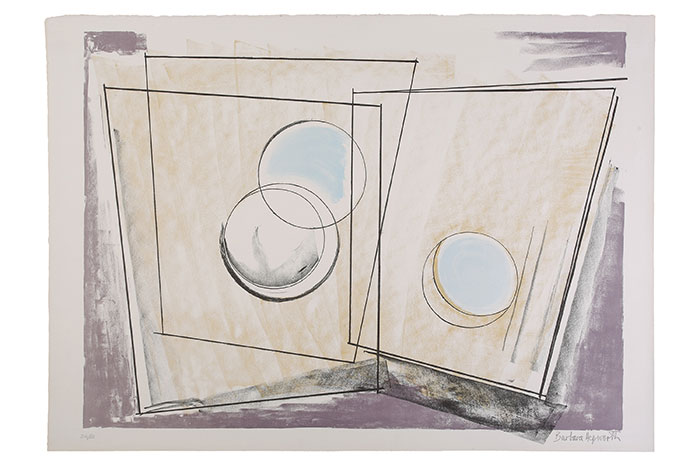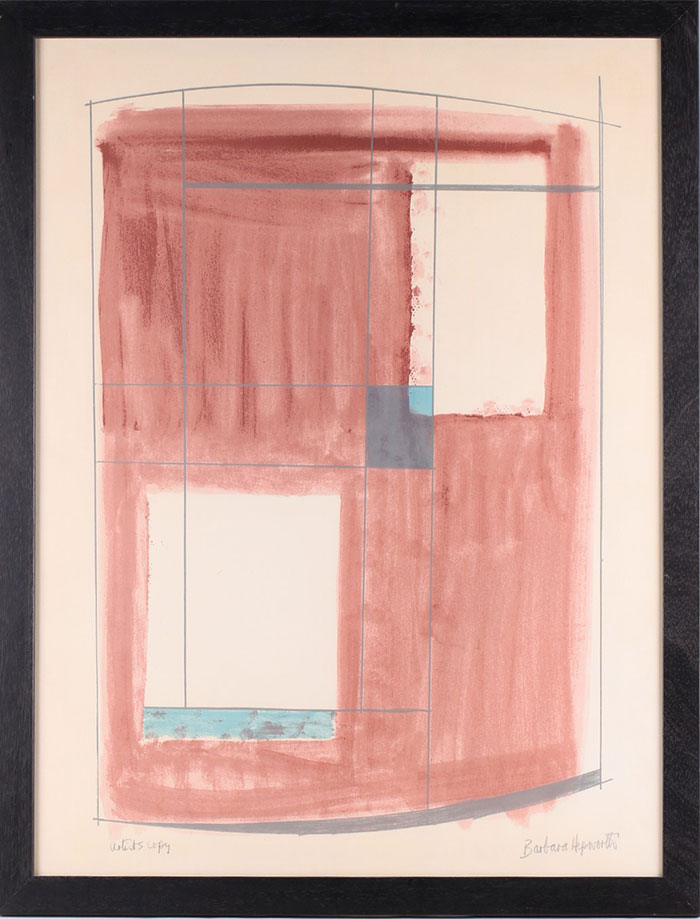A Guide to the Work of Barbara Hepworth
Hepworth remains a revered figure both within the British Modernist movement and internationally
29/07/2024
“All my early memories are of forms and shapes and textures. Moving through and over the West Riding landscape with my father in his car, the hills were sculptures; the roads defined the forms.”- Barbara Hepworth, speaking in the BBC film Barbara Hepworth (Dir. John Read, 1961)
Dame Jocelyn Barbara Hepworth was a leading artist of the mid-20th century modern movement. Working predominantly with wood, stone and metal, her abstract sculptures exemplify modernism through masterful rendering and poetic forms.
Born in 1903 on the 10th of January in Wakefield, Yorkshire, Hepworth was educated at Wakefield Girls High. She attended the Leeds School of Art in 1919, where she met fellow student, Henry Moore, who would become a lifelong friend and genial rival. In 1921 she was awarded a scholarship to the Royal College of Art in London and following her graduation in 1924, she was runner-up for the Prix-de-Rome scholarship, which was won by sculptor John Skeaping. Instead, Hepworth travelled to Florence on a West Riding Travel Scholarship and learned how to carve marble from sculptor Giovanni Ardini.
Barbara Hepworth (1903 - 1975), 'Oblique Forms'
Skeaping and Hepworth became acquainted through mutual friend Henry Moore, following a whirlwind romance in Rome and Siena, the pair married in Florence in May 1925 before moving to Rome together, where they began carving in stone. Newly proficient in the art of “direct carving”, the couple returned to London in November 1926 and shortly after they started to exhibit their sculptures from their studio in a flat at 24 St Ann’s Terrace. One of their early customers was art collector George Eumorfopoulos, who purchased two of Hepworth’s creations – “Seated Figure” and “Mother and Child” - and introduced them to many influential figures within the art world.
In 1928 they moved to 7 The Mall Studios in Hampstead and in August the following year their son Paul was born. Hepworth and Skeaping held successful joint exhibitions at Beaux Arts Gallery, London, Alex Reid and Lefevre, Glasgow, and Tooth’s, but their relationship broke down and they were separated by 1931. Hepworth moved through avant-garde artistic circles including the London Group and the 7 & 5 Society, where she met and fell in love with, abstract painter, Ben Nicholson - then married to Winifred Nicholson.
Hepworth’s earliest work could be described as naturalistic, evolving to entirely abstract by the 1930s. She experimented with collage, photograms and prints, and her sculpture became increasingly focused on geometric forms, straight edges, and immaculate surfaces. She pioneered the piercing of the block which became characteristic of her own work, and later of Henry Moore.
In 1933 Hepworth and Skeaping were amicably divorced, and she travelled with Nicholson to France where they visited the studios of Jean Arp, Pablo Picasso, and Constantin Brâncuși. They subsequently joined the Abstraction-Création, and together with Paul Nash, Herbert Read, and Wells Coates founded the art movement, Unit One. Their efforts to raise awareness of continental artists culminated in 1937 with the publication of Circle: An International Survey of Constructivist Art, which was edited by Nicholson, Naum Gabo, and Leslie Martin, and co-designed by Hepworth.
Barbara Hepworth (1903-1975), 'Rangatira II'
In 1934 Hepworth gave birth to triplets with Nicholson, Rachel, Sarah, and Simon; and on the 17th of November 1938, Hepworth married Nicholson at the Hampstead Registry Office.
“The work was more formal, and all traces of naturalism had disappeared, and for some years I was absorbed in the relationships in space, in size and texture and weight, as well as in the tensions between the forms”. – Barbara Hepworth on her work after giving birth to the triplets.
When World War II broke in 1939, Hepworth and her family were evacuated to St Ives in Cornwall, and it is with Cornwall that her work is now most closely associated. She started to incorporate landscape references in her work, moving away from pure abstraction, she created her first stringed sculptures, which she attributed to “the strings were the tension I felt between myself and the sea, the wind or the hills.”
Her first solo exhibition took place at Temple Newsam, Leeds in 1943.
The hospitalisation of Hepworth’s daughter in 1944, resulted in a friendship with surgeon, Norman Capener, who later invited her to view surgical procedures. Between 1947 and 1949 Hepworth produced almost eighty drawings of operating rooms in chalk, ink and pencil.
Hepworth exhibited in the 1950 British Pavilion at the XXV Venice Biennale which was the last time contemporary British artists were exhibited alongside traditional artists.
Barbara Hepworth DBE (1903-1975) British, 'Two Forms (Atlantic)', polished bronze
On 8 February 1949, Hepworth co-founded the Penwith Society of Artists together with Nicholson, Peter Lanyon, Bernard Leach and fifteen other artists. As St Ives had become somewhat of a sanctuary for artists during the war, the move sought to attract international attention. She purchased Trewyn Studio where she would live after her divorce from Nicholson in 1951, the same year she had a solo exhibition at Wakefield Art Gallery, which toured to York and Manchester. During this time Hepworth started to move away from working only in stone or wood and began to work with bronze, slate and clay.
Paul Skeaping, Hepworth’s eldest son, was tragically killed in a plane crash in Thailand on the 13th of February 1953 while serving the Royal Air Force. Exhausted and overwhelmed, Hepworth sought refuge in Greece with her friend Margaret Gardiner the following year. Gardiner arranged a large shipment of Nigerian guarea hardwood to be delivered to Hepworth when she returned to St Ives. Over the next two years Hepworth sculpted six pieces out of the hardwood, mostly inspired by her trip to Greece.
Hepworth achieved many accolades and awards throughout her prolific later years, including being made a Dame and a Tate trustee in 1965. She was especially active within, and on behalf, of the modernistic art community of St Ives. In 1968 she was awarded the Freedom of St Ives in acknowledgement of her contributions to the town.
After a long battle with cancer, Hepworth died in a horrifying fire at her St Ives studio on the 13th of May 1975. She is buried in the town cemetery in a grave marked by a self-carved monument, and her studio has been designated the Barbara Hepworth Museum.
Hepworth remains a revered figure both within the British Modernist movement and internationally. Some of her most significant commissions include Contrapuntal Forms and Turning Forms for the Festival of Britain (1951), Monolith (1953) – on display in the grounds of Kenwood – Meridian (1958–9) for State House in High Holborn, London, and Winged Figure (1962), which can be viewed outside the John Lewis store on Oxford Street.
“Perhaps what one wants to say is formed in childhood and the rest of one’s life is spent trying to say it. I know that all I felt during the early years of my life in Yorkshire is dynamic and constant in my life today.” - Barbara Hepworth
Related Articles
How Can You Tell if a Painting is Rare?
Do you have art by Barbara Hepworth that you are looking to sell?
With a global audience of over 10 million active bidders, Dawsons can secure the highest prices for you when you sell art.
Get in touch with one of our expert Valuers for confidential sales advice, we would be delighted to help:


